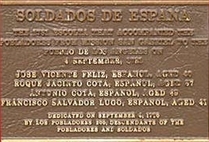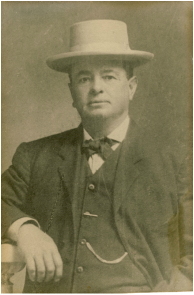 A personal family journey This blog is about my own family history and why Solano Canyon means so much to me, 246 years after the first of my ancestors came to California in 1769. It is an attempt to explain why the 3/16 part of my blood that is Hispanic has become the most important part of my ethnic heritage and the part of which I am the most proud. I hope you will share this journey with me. José Manuel Pérez Nieto Manuel Nieto was born circa 1734 in la Villa de San Felipe y Santiago de Sinaloa, Nueva España, more commonly called simply la Villa de Sinaloa. His mother is Manuela Pérez and his father is José Nieto. In the 1790 padrón (census) of the Presidio of San Diego, Manuel Nieto, mulato, is listed along with his mother, Manuela Pérez, española, which means, in the rigid racial classification system in place at the time, that Manuel's father, who is not listed and is presumably dead by then, was black. Manuel Nieto is the first of my ancestors to have come into what is now the State of California, as a soldier in the company of Gaspar Portolá. Manuel Nieto married María Teresa Morillo, a native of Loreto in what is now Baja California, about 1775, presumably in Loreto. They had six children, one of whom is a daughter, María Manuela Antonia Pérez Nieto. María Manuela Antonia Pérez Nieto Manuela Nieto was the fifth of six children of Manuel Nieto and María Teresa Morrillo. She was baptized at Mission San Gabriel in 1791. When her father died in 1804, she inherited Rancho los Cerritos, one of the five ranchitos that once made up the vast Rancho la Zanja, the 330,000-acre grant of her father's from King Carlos III of Spain in 1784, the second of only four such royal grants in California. The boundaries of the grand were defined as "... all the land between the San Gabriel and Santa Ana Rivers, and from the crest of the Saddleback Mountains to the sea." Roque Jacinto de Cota Roque Cota was born circa 1724 in the mysterious Villa del Fuerte in what is now Sinaloa, México. He married Juana María Rita Verdugo in Loreto (now in Baja California) circa 1755. They had 11 children, of whom, the fourth was Juan Ygnacio Guillermo, who was born in Loreto circa 1768, and of whom, more later. Roque Cota was a soldado de cuera, a so-called 'leather-jacket' soldier in the Spanish Colonial army. He was one of four soldiers who comprised the escolta (escort) who came to Los Angeles from Mission San Gabriel along with the 44 pobladores (settlers, literally 'residents') who first settled what is now Los Angeles, arriving September 4, 1781. His name is memorialized on a bronze plaque in the Plaza of downtown Los Angeles, along with that of his younger brother, Antonio, who was also a member of the escolta. Juan Ygnacio Guillermo Cota Guillermo Cota was born circa 1768 in Loreto, the fourth of 11 children of Roque Cota and Juana María Verdugo. He married first, María Manuela de Jesús Lisalde in 1794 at Mission San Gabriel Arcángel. They had four children before Manuela died at Santa Bárbara in 1803. Hers is one of the earliest burials in the Mission at Santa Bárbara. Guillermo married, second, at Mission San Gabriel in 1805, 13-year-old Manuela Nieto, daughter of Manuel Nieto. They had 13 children, of whom, the ninth was María Loreta Cota, born in 1824 and baptized in the downtown Plaza Church. Guillermo Cota was alcalde mayor (mayor) of the Pueblo of Los Angeles three times: 1798–1799, again in 1824, and finally in 1827–1828. He once had a large lot and an adobe house on Main Street. María Loreta Cota Loreta Cota was born in Los Angeles and baptized in the Plaza Church in 1824, the daughter of Guillermo Cota and Manuela Nieto. In May, 1847, when she was 22 years old, the ayntamiento (city government) granted her title to a 100-vara (278.1 feet) square lot downtown. The property was located in what is now about 2/3 of the block between Main and Spring Streets and between Third and Fourth Streets, beginning about 90 feet south of Third Street. She died a widow in Los Angeles in 1905. Jean Bouet Meanwhile in France, Jean Bouet was born in 1813 in Mont-de-Marsan, a village about 50 miles south of Bordeaux, the sixth of six children of Antoine Agustín Bouët and Jeanne Dauga. When he arrived in California is not certain, but it was around 1830. In any case, he became known as Juan Bouet, and he married Loreta Cota in the Plaza Church in 1847. They had eight children, the sixth of whom was a son, Guillermo, of whom, more later. Juan Bouet owned land just northeast of the Stone Quarry Hills as shown on an 1868 map, in an area by the Los Angeles River that is today called Frogtown. His neighbors, as may be seen, were Mariano and Julián Chávez.  Guillermo Bouett, ca. 1890 Guillermo Bouett, ca. 1890 Guillermo Bouett Guillermo Bouett was born in Los Angeles in October 1857, the sixth child of Juan Bouett and Loreta Cota. He eventually became a Captain in the Los Angeles County Sheriff's Department and was killed in the line of duty in 1913. The story of his death, while tragic, is not without its element of humor, at least when seen from the distance more than of 100 years. William Bouett, as he was called, had a favorite horse named Jack. Jack was trained so that he could be mounted from the rear. William Bouett simply ran up to his horse, put his hands on Jack's haunches, and leapt aboard. Captain Bouett was working with a chain gang in 1913 near Azusa, when one of the prisoners, who had been unshackled so he could get a drink of warer, saw an opportunity to escape and he began to run. The Captain, seeing the fleeing prisoner, ran to Jack and leapt on. He got one boot in a stirrup, but Jack took off a moment too soon. Captain Bouett was thrown, and when he fell, he broke his neck and was killed instantly. His body was brought back to Los Angeles in a wagon. Francisco Sales de Jesús Solano .Francisco Solano was born in 1817 in Ujarrás, in the province of Cartago in Costa Rica. He is the son of Felipe Solano and Juana Alvarado. The Solano line is an old one in Costa Rica, probably going back to a Spaniard of the same surname who arrived on the Caribbean coast in 1565 as a soldier.  María Agustina Solano, ca. 1880 María Agustina Solano, ca. 1880 María Rosa de las Mercedes Casanova Rosa Casanova was born on the Mosquito Coast of Costa Rica or Honduras in 1840, the second of four daughters of Antonio Casanova of Sant Felíe de Guixols in Cataluña, Spain and María Trinidad Serrano Puentes of Maracaibo in Zulia, Venezuela. Antonio and Trinidad had one daughter in Jamaica, then Rosa, then two others in Costa Rica. One of the daughters did not survive to adulthood. Rosa's father, Antonio Casanova, and Francisco Solano somehow became acquainted, and when the Casanova family left Costa Rica for Los Angeles sometime between 1848 and 1850, Francisco Solano accompanied them. Thirty-seven-year-old Francisco Solano and 13-year-old Rosa Casanova were married by a juez de paz (Justice of the Peace) in Los Angeles in 1854; they were re-married in the Plaza Church by a priest in 1857. They had six children, the second of whom was Alfredo, born in 1857, and the fourth of whom was María Agustina, born in 1862. María Agustina Solano María Solano was born in Los Angeles in 1861. Shortly after 1866, when her father, Francisco Solano, bought 87 acres of land in the Stone Quarry Hills, she moved into what is now Solano Ravine to an adobe that was built for his family by her father. It must have been a very quiet life up in the hills, living on a stream what flowed from a spring higher up the ravine. María Agustina Solano and Guillermo Bouett were married in the Plaza Church in Los Angeles in 1881. They built a house during the 1890s at 1425 Buena Vista Road, on the corner of Buena Vista Road and Casanova Street, where they lived until William Bouett's death in 1913; María continued to live in the house until shortly before 1920, when she moved to Long Beach to live with one of her daughters. The retaining wall for the lot is constructed from mortared stone that was quarried from the Stone Quarry Hills and is still visible on North Broadway at Casanova Street. Why I Love Solano Canyon This rather long narrative has finally come to an end. It has brought together at least four strands of my ancestry — one French and three Hispanic — that have brought me, over nine generations and 325 years from 1680 in San José del Cabo in Baja California to the present, to Solano Canyon in Los Angeles, California. I feel as if Solano Canyon is my home, despite the fact that I have never lived there. When I walk its streets, I can feel my ancestors — Nieto and Morillo, Cota and Verdugo, Solano and Casanova, and Bouett and Solano — especially my great-grandparents, Guillermo Bouett and María Solano, but also María's brother Alfredo Solano, all of whom contributed in some way to make me who I am, and all of whom contributed to the fact that Solano Canyon is a community today. It is these people on whose shoulders I stand, and Solano Canyon is the physical manifestation of that pedestal. When I am in Solano Canyon, I feel like I am at home. And that is why I love Solano Canyon. Puede que Díos bendice a la gente de Solano Cañon — mis hermanos, mis primos, mis amigos. |
About the AuthorLawrence Bouett is a retired research scientist and registered professional engineer who now conducts historical and genealogical research full-time. A ninth-generation Californian, his primary historical research interests are Los Angeles in general and the Stone Quarry Hills in particular. His ancestors arrived in California with Portolá in 1769 and came to Los Angeles from Mission San Gabriel with the pobladores on September 4, 1781. Lawrence Bouett may be contacted directly here.
Archives
July 2018
Categories |





 RSS Feed
RSS Feed
